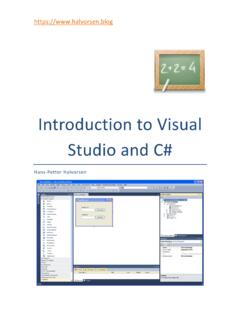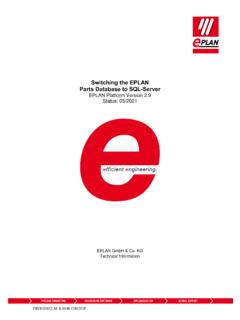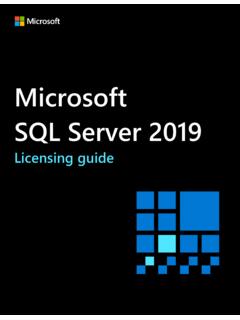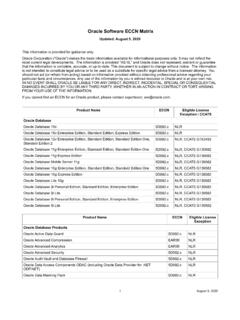Transcription of Structured Query Language - halvorsen.blog
1 Available Online: Structured Query Language Hans-Petter Halvorsen Structured Query Language Hans-Petter Halvorsen Copyright 2017 3 Table of Contents 1 Introduction to SQL .. 6 Data Definition Language (DDL) .. 8 Data Manipulation Language (DML) .. 8 2 Introduction to SQL server .. 9 SQL server Management Studio .. 10 Create a new Database .. 11 Queries .. 12 3 CREATE TABLE .. 13 Database Modelling .. 15 Create Tables using the Designer Tools .. 17 SQL Constraints .. 17 PRIMARY KEY .. 18 FOREIGN KEY .. 19 NOT NULL / Required Columns .. 22 UNIQUE .. 23 CHECK .. 25 DEFAULT .. 27 AUTO INCREMENT or IDENTITY .. 28 ALTER TABLE .. 29 4 INSERT INTO .. 31 5 UPDATE .. 33 4 Table of Contents Structured Query Language (SQL) 6 DELETE .. 35 7 SELECT .. 37 The ORDER BY Keyword.
2 39 SELECT DISTINCT .. 40 The WHERE Clause .. 40 Operators .. 41 LIKE Operator .. 41 IN Operator .. 42 BETWEEN Operator .. 42 Wildcards .. 42 AND & OR Operators .. 43 SELECT TOP Clause .. 44 Alias .. 45 Joins .. 45 Different SQL JOINs .. 46 8 SQL Scripts .. 48 Using Comments .. 48 Single-line comment .. 48 Multiple-line comment .. 48 Variables .. 49 Built-in Global Variables .. 50 @@IDENTITY .. 50 Flow Control .. 51 IF ELSE .. 51 WHILE .. 52 CASE .. 53 5 Table of Contents Structured Query Language (SQL) CURSOR .. 54 9 Views .. 56 Using the Graphical Designer .. 57 10 Stored Procedures .. 61 NOCOUNT ON/NOCOUNT OFF .. 64 11 Functions .. 66 Built-in Functions .. 66 String Functions .. 66 Date and Time Functions .. 67 Mathematics and Statistics Functions.
3 67 AVG() .. 68 COUNT() .. 68 The GROUP BY Statement .. 69 The HAVING Clause .. 70 User-defined Functions .. 71 12 Triggers .. 72 13 Communication from other Applications .. 75 ODBC .. 75 Microsoft Excel .. 76 14 References .. 78 6 1 Introduction to SQL SQL ( Structured Query Language ) is a database computer Language designed for managing data in relational database management systems (RDBMS). SQL, is a standardized computer Language that was originally developed by IBM for querying, altering and defining relational databases, using declarative statements. SQL is pronounced / s kju l/ (letter by letter) or / si kw l/ (as a word). What can SQL do? SQL can execute queries against a database SQL can retrieve data from a database SQL can insert records in a database SQL can update records in a database SQL can delete records from a database 7 Introduction to SQL Structured Query Language (SQL) SQL can create new databases SQL can create new tables in a database SQL can create stored procedures in a database SQL can create views in a database SQL can set permissions on tables, procedures, and views Even if SQL is a standard, many of the database systems that exist today implement their own version of the SQL Language .
4 In this document, we will use the Microsoft SQL server as an example. There are lots of different database systems, or DBMS Database Management Systems, such as: Microsoft SQL server o Enterprise, Developer versions, etc. o express version is free of charge Oracle MySQL (Oracle, previously Sun Microsystems) - MySQL can be used free of charge (open source license), Web sites that use MySQL: YouTube, Wikipedia, Facebook Microsoft Access IBM DB2 Sybase .. lots of other systems In this Tutorial, we will focus on Microsoft SQL server . SQL server uses T-SQL (Transact-SQL). T-SQL is Microsoft's proprietary extension to SQL. T-SQL is very similar to standard SQL, but in addition it supports some extra functionality, built-in functions, etc. 8 Introduction to SQL Structured Query Language (SQL) Other useful Tutorials about databases: Introduction to Database Systems Database Communication in LabVIEW These Tutorials are located at: Data Definition Language (DDL) The Data Definition Language (DDL) manages table and index structure.
5 The most basic items of DDL are the CREATE, ALTER, RENAME and DROP statements: CREATE creates an object (a table, for example) in the database. DROP deletes an object in the database, usually irretrievably. ALTER modifies the structure an existing object in various ways for example, adding a column to an existing table. Data Manipulation Language (DML) The Data Manipulation Language (DML) is the subset of SQL used to add, update and delete data. The acronym CRUD refers to all of the major functions that need to be implemented in a relational database application to consider it complete. Each letter in the acronym can be mapped to a standard SQL statement: Operation SQL Description Create INSERT INTO inserts new data into a database Read (Retrieve) SELECT extracts data from a database Update UPDATE updates data in a database Delete (Destroy) DELETE deletes data from a database 9 2 Introduction to SQL server Microsoft is the vendor of SQL server .
6 We have different editions of SQL server , where SQL server express is free to download and use. SQL server uses T-SQL (Transact-SQL). T-SQL is Microsoft's proprietary extension to SQL. T-SQL is very similar to standard SQL, but in addition it supports some extra functionality, built-in functions, etc. T-SQL expands on the SQL standard to include procedural programming, local variables, various support functions for string processing, date processing, mathematics, etc. SQL server consists of a Database Engine and a Management Studio (and lots of other stuff which we will not mention here). The Database engine has no graphical interface - it is just a service running in the background of your computer (preferable on the server ). The Management Studio is graphical tool for configuring and viewing the information in the database.
7 It can be installed on the server or on the client (or both). 10 Introduction to SQL server Structured Query Language (SQL) SQL server Management Studio SQL server Management Studio is a GUI tool included with SQL server for configuring, managing, and administering all components within Microsoft SQL server . The tool includes both script editors and graphical tools that work with objects and features of the server . As mentioned earlier, version of SQL server Management Studio is also available for SQL server express Edition, for which it is known as SQL server Management Studio express . A central feature of SQL server Management Studio is the Object Explorer, which allows the user to browse, select, and act upon any of the objects within the server . It can be used to visually observe and analyze Query plans and optimize the database performance, among others.
8 SQL server Management Studio can also be used to create a new database, alter any existing database schema by adding or modifying tables and indexes, or analyze performance. It includes the Query windows which provide a GUI based interface to write and execute queries. When creating SQL commands and queries, the Query Editor (select New Query from the Toolbar) is used (shown in the figure above). With SQL and the Query Editor we can do almost everything with code, but sometimes it is also a good idea to use the different Designer tools in SQL to help us do the work without coding (so much). 11 Introduction to SQL server Structured Query Language (SQL) Create a new Database It is quite simple to create a new database in Microsoft SQL server . Just right-click on the Databases node and select New There are lots of settings you may set regarding your database, but the only information you must fill in is the name of your database: 12 Introduction to SQL server Structured Query Language (SQL) You may also use the SQL Language to create a new database, but sometimes it is easier to just use the built-in features in the Management Studio.
9 Queries In order to make a new SQL Query , select the New Query button from the Toolbar. Here we can write any kind of queries that is supported by the SQL Language . 13 3 CREATE TABLE Before you start implementing your tables in the database, you should always spend some time design your tables properly using a design tool like, , ERwin, Toad Data Modeler, PowerDesigner, Visio, etc. This is called Database Modeling. The CREATE TABLE statement is used to create a table in a database. Syntax: CREATE TABLE table_name ( column_name1 data_type, column_name2 data_type, column_name3 data_type, .. ) The data type specifies what type of data the column can hold. 14 CREATE TABLE Structured Query Language (SQL) You have special data types for numbers, text dates, etc. Examples: Numbers: int, float Text/Stings: varchar(X) where X is the length of the string Dates: datetime etc.
10 Example: We want to create a table called CUSTOMER which has the following columns and data types: CREATE TABLE CUSTOMER ( CustomerId int IDENTITY(1,1) PRIMARY KEY, CustomerNumber int NOT NULL UNIQUE, LastName varchar(50) NOT NULL, FirstName varchar(50) NOT NULL, AreaCode int NULL, Address varchar(50) NULL, Phone varchar(50) NULL, ) GO Best practice: When creating tables you should consider following these guidelines: Tables: Use upper case and singular form in table names not plural, , STUDENT (not students) Columns: Use Pascal notation, , StudentId Primary Key: o If the table name is COURSE , name the Primary Key column CourseId , etc. 15 CREATE TABLE Structured Query Language (SQL) o Always use Integer and Identity(1,1) for Primary Keys. Use UNIQUE constraint for other columns that needs to be unique, RoomNumber Specify Required Columns (NOT NULL) , which columns that need to have data or not Standardize on few/these Data Types: int, float, varchar(x), datetime, bit Use English for table and column names Avoid abbreviations!


















